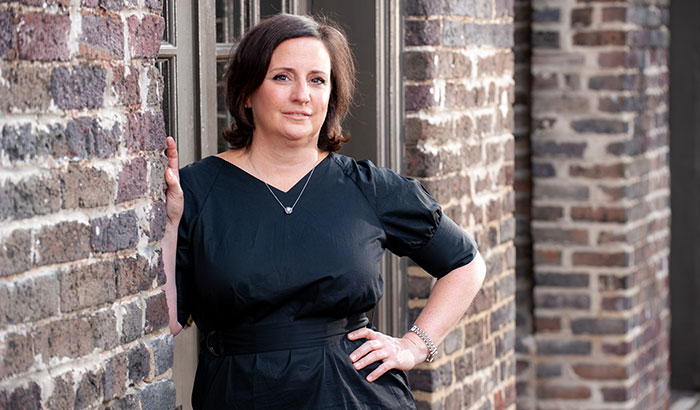Office of Research & Development |
 |


Dr. Ann Elizabeth Montgomery is an investigator with VA’s National Center on Homelessness Among Veterans. (Photo by Joe De Sciose)
April 11, 2019
By Mitch Mirkin
VA Research Communications
"There are some Veterans who really want to be with other Veterans. They feel like they have an important common understanding."
Veteran homeless has declined dramatically in recent years, thanks in large part to a variety of steps taken by VA. But the problem is by no means solved.
The Department of Housing and Urban Development reported that on a single night in January 2018, there were nearly 38,000 Veterans experiencing homelessness—including those staying in shelters. The number was down from around 74,000 in 2010.
VA’s National Center on Homelessness Among Veterans spearheads an array of programs aimed at further drawing down the number of Vets without housing. Dr. Ann Elizabeth Montgomery, based in Birmingham, Alabama, has been an investigator with the Center since it started in 2009. Prior to her VA career, she had volunteered at a homeless shelter and a domestic violence center and worked at the New York City Department of Homeless Services. She had also conducted research on homelessness.
Podcast: Housing for homeless Veterans
VA Research Currents talked with Montgomery about a study by her group that came out in early 2019 titled “Veterans’ Assignment to Single-Site Versus Scattered-Site Permanent Supportive Housing.” The conversation focused on the HUD-VASH program and the types of living situations it offers Veterans.
The models you looked at in your study involved HUD-VASH [Housing and Urban Development–VA Supportive Housing]. Could you give us a bit of background on this program.
HUD-VASH is the largest permanent supportive housing program in the country, and it’s intended for Veterans who have experienced homelessness and need additional support maintaining housing. It’s been around since the 1990s. There were very few vouchers then, and it’s really ramped up since about 2008.
What HUD-VASH does is provide Housing Choice vouchers—what we used to call Section 8 vouchers. There are now probably around 90,000 to 95,000 HUD-VASH vouchers funded throughout the country, among many more general Housing Choice vouchers that HUD provides. And VA provides supportive services, case management, and health care. That’s how it becomes permanent supportive housing.

Photos shed light on food insecurity in post 9/11 Veterans

Homeless Veterans largely satisfied with community health care options

Conference to examine health, legal issues involving Veterans and others who break the law
The voucher is permanent, and Veterans can take it and look for private-market rental apartments, or what we call “scattered-site apartments,” in the community. The Veterans have to pay only a third of their income toward rent. The voucher pays the rest.
There are also what we call “project-based programs,” where the vouchers stay with the housing unit. So there could be a building that has multiple units, and Veterans can choose to move into one of those units. When a Veteran moves out, the unit becomes vacant, the voucher opens again, and another Veteran can move in.
HUD-VASH and other programs like it are very effective. Studies have found that about 85% of people who move into these permanent supportive programs are able to maintain their housing for a year or more.
It’s also important to note that HUD-VASH takes the Housing First approach. That means if Veterans have substance use or mental health issues or other disabling conditions, they are not required to “fix” those issues before they move into housing. They don’t have to be housing-ready. The underlying philosophy is that once someone gets into housing, that’s a stable platform from which they can live a healthier life, fuller life, and they can address their goals.
Your team reviewed the existing literature on single-site (or project-based) housing versus scattered-site. What emerged as the top pros and cons of these two approaches?
One of the big advantages to single-site housing is that if you have a case manager who is working with, say, 30 people, and they’re spread throughout a large city, that takes a lot of time, because there’s a big focus on having home-based visits. In the single-site model, the Veterans end up having more one-to-one interaction with service providers. Also, there may be less social isolation because you’re living in a building with others who may have similar interests just by virtue of their being fellow Veterans.
On the other hand, some research has found that single-site can be isolating because the Veteran may not feel part of the mainstream community. These programs are supposed to be just like other types of permanent supportive housing, just as if the Veterans were in scattered-site units in the community, but in this model, they are grouped together. It shouldn’t feel like an institution. But there definitely are more staff present than there would be in your own apartment.
As part of the study, you also held focus groups with VA professionals who provide services at 10 of these single-site programs in 10 different cities. What did you hear from them?
We heard a lot about how single-site programs are really useful for Veterans who may have a history of eviction or history of a felony offense and just can’t find anywhere else to rent a place. No other landlord is willing to rent to them because they seem like a high-risk tenant.
We also heard about the utility of these programs as a stepping stone to something more independent. For example, if a Veteran really wants an apartment in a certain neighborhood but there are none at the moment that he or she can afford or that are willing to take a Housing Choice voucher, they may move into the project-based, single-site program and then get a different type of voucher later and move in to other types of housing.
The final thing that we heard about the utility of these programs is for Veterans who are aging or sick and who don’t need to be in a nursing home but do need more support than they would get living in a scattered-site unit. These programs are really useful for that demographic.
Are single-site units typically in neighborhoods that are considered quiet and safe? Could they be in more urban locales, near the same streets where these folks might’ve been living homeless?
The answer is, both. If the program is located on skid row, there are interesting challenges that come with that. There can be issues around drug dealing, prostitution. The street can move into the building to some degree. If you’re wanting to get into permanent housing and work on substance abuse issues and your old drug dealer is down the block, that can be a problem. On the other hand, if someone has been living in the core downtown area and they’re moved up to the suburbs where they don’t know anyone, where they’re far from their doctor, that could also be a problem, especially if they don’t drive.
What have you learned about the social bonding that goes on among Veterans living at the same single site?
There are some Veterans who really want to be with other Veterans. They feel like they have an important common understanding. For some people, that’s really a positive aspect of these single-site programs. Staff gave us examples about how Veterans would take care of each other. The younger Veterans help out the older Veterans. Particularly in these mission-driven single-site programs that are created specifically for Veterans, that’s the message they’re getting: “We’re here for you. We’re here together.”
Is there any attempt to group homeless Veterans into residential settings based on the types of issues they’re dealing with?
We don’t believe there’s a benefit to separating people based on the issues that they are dealing with. We did hear that one thing that could be a problem is if there someone who has a history of substance use and is really hoping to stay clean and sober but there are other people actively using who live at the site. It can be really triggering if you’re trying to stay clean and you can smell someone smoking crack next door.
Is there overlap between the Veteran populations served by HUD-VASH and VA’s Mental Health Residential Rehabilitation and Treatment Programs?
These treatment programs are for just that, treatment. Permanent supportive housing through HUD-VASH is for housing. You can access treatment if you need it, and it needs to be made available to you. And you have choice about any treatment that you decide to access. But treatment is not the ultimate goal. The ultimate goal is to end homelessness.
The other issue is that permanent supportive housing is permanent. So even if you’re in one of these single-site buildings, you get this voucher and as long as you’re eligible for the voucher, as long as you meet your income eligibility, and you continue to be a good neighbor, you can stay there. These other programs are time-limited. If you’re homeless and you go into a domiciliary program, or you’re homeless and you go into a residential treatment program, you’re still homeless. When you go into HUD-VASH, you’re housed.
VA Research Currents archives || Sign up for VA Research updates